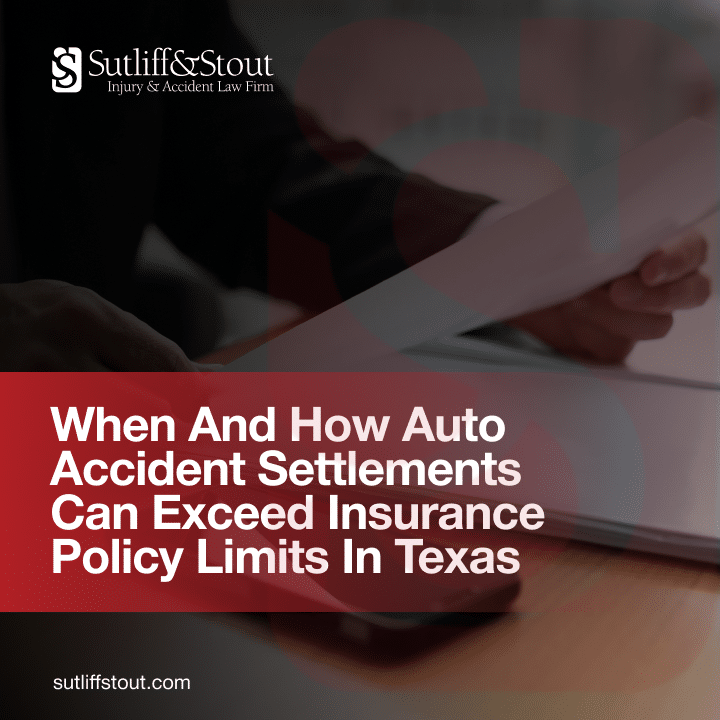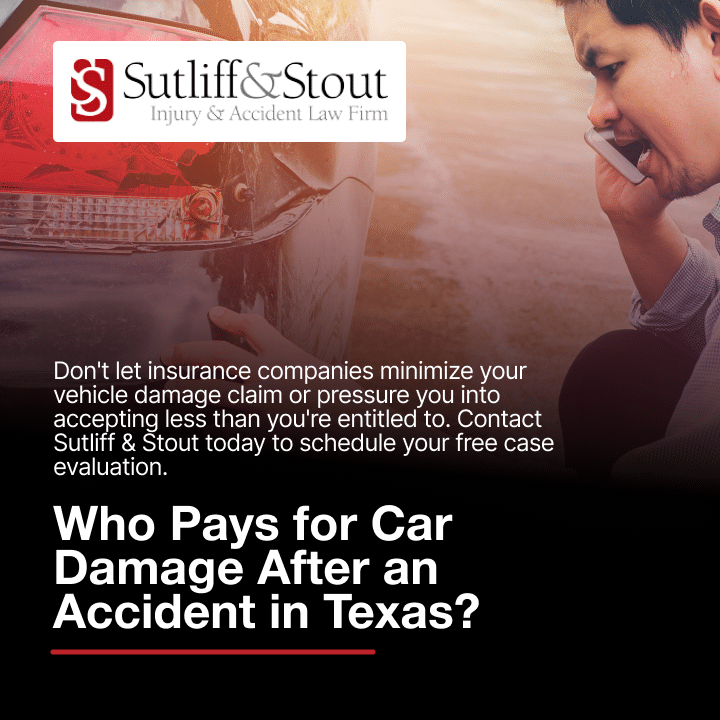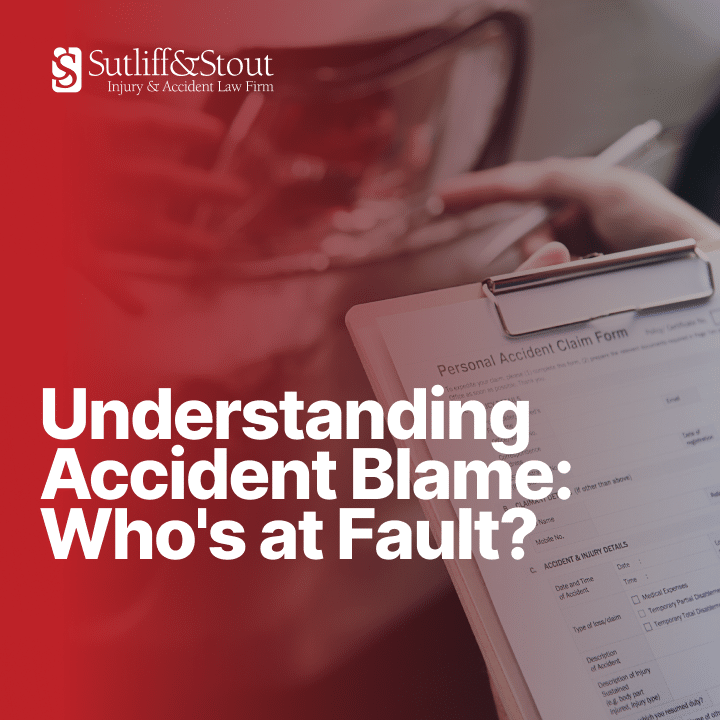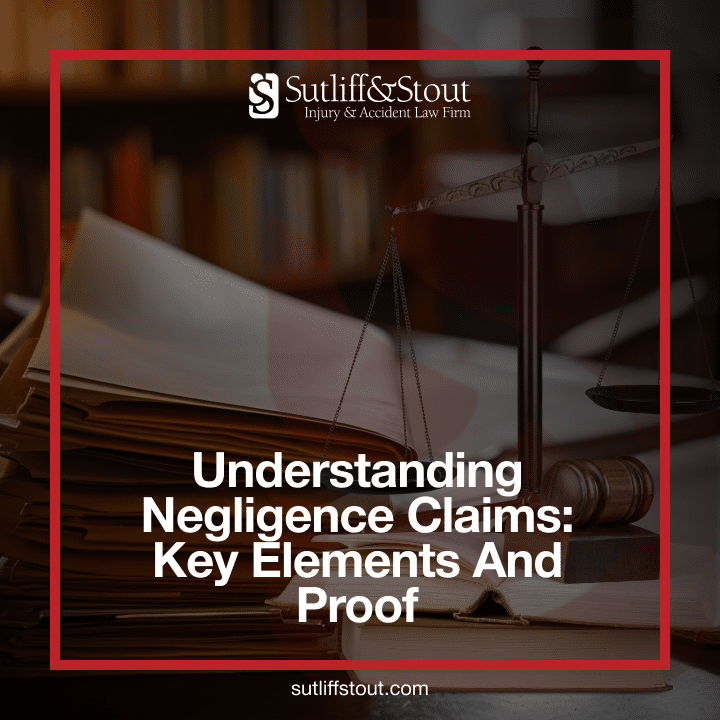
In Texas, auto accident settlements are typically governed by the insurance policy limits of the parties involved. However, there are situations where a settlement can exceed the at-fault driver’s policy limits. If you are involved in an accident and the insurance policy limits fall short of covering your expenses, understanding when and how settlements can exceed those limits is crucial. The experienced auto accident attorneys at Sutliff & Stout can help you navigate these complex situations and pursue a fair settlement.
How Are Insurance Policy Limits Determined in Texas?
In Texas, auto insurance policies have specific limits on the amount of money that can be paid out in the event of an accident. These limits vary depending on the type of coverage chosen by the driver.
State Minimum Requirements
Texas law requires drivers to carry a minimum amount of liability insurance, which includes coverage for bodily injury and property damage. As of 2025, the minimum required liability limits in Texas are:
$30,000 for injury or death to one person
$60,000 for injury or death to more than one person
$25,000 for property damage
These minimums are intended to cover basic expenses, but they may not be enough in more serious accidents.
When Can Settlements Exceed Policy Limits?
There are situations where an auto accident settlement can exceed the at-fault party’s insurance policy limits.
Severe Traumatic Brain Injury (TBI)
Scenario: A motorcyclist is struck by a distracted driver while crossing an intersection. The motorcyclist suffers a severe traumatic brain injury (TBI), resulting in long-term cognitive impairment and physical disabilities.
Damages: The medical treatment for a severe TBI may include emergency surgeries, rehabilitation, cognitive therapy, and possibly lifelong care. The victim may also experience a significant loss of earning capacity due to the inability to return to work in their previous profession.
Insurance Policy Limits: The at-fault driver’s insurance policy only covers $30,000 in bodily injury. However, the victim’s medical bills alone total $300,000, and future care costs could reach millions over their lifetime. The victim’s pain and suffering, loss of quality of life, and lost income would also exceed the available policy limits.
Spinal Cord Injury Resulting in Paralysis
Scenario: A young, healthy individual is rear-ended by a commercial truck at high speed while stopped at a red light. The impact causes a severe spinal cord injury, resulting in paralysis from the waist down.
Damages: The victim faces immediate surgery, a long hospital stay, and extensive physical therapy. The long-term costs include adaptive housing, wheelchairs, a personal caregiver, and ongoing medical treatments. They may also face emotional trauma and reduced quality of life.
Insurance Policy Limits: If the truck driver’s insurance policy provides only $500,000 in liability coverage, this is nowhere near sufficient to cover the medical expenses, modifications to the home, lost income, and other damages that could total over $2 million or more for a lifetime of care.
Multiple Broken Bones and Organ Damage
Scenario: A pedestrian is struck by a car while walking in a crosswalk. The pedestrian sustains multiple broken bones, internal organ damage, and requires extensive surgeries and a lengthy recovery period.
Damages: Medical bills for surgeries, rehabilitation, hospital stays, and ongoing treatments could exceed $200,000. Additionally, the victim loses significant income due to being unable to work for months. There may also be pain and suffering damages and permanent scarring.
Insurance Policy Limits: The driver’s insurance policy may cover only $30,000 for bodily injury, which is far below the total damages. Even if the pedestrian’s medical bills and lost wages are covered by the policy, this does not account for pain and suffering, future medical costs, or non-economic damages.
Wrongful Death
Scenario: A family loses a loved one due to a fatal crash caused by a drunk driver. The deceased was a primary breadwinner, and their death leaves the family without their financial and emotional support.
Damages: Funeral expenses, loss of future earnings, and loss of companionship for the surviving family members can quickly surpass the policy limits. The surviving spouse and children may also be entitled to compensation for the emotional suffering and loss of society.
Insurance Policy Limits: The at-fault driver may have a minimum policy of $30,000 for bodily injury, but this amount will not come close to covering the funeral costs, loss of future income, and the emotional damages the family endures. In Texas, wrongful death cases can involve significant compensation for future lost wages and the loss of support from the deceased.
Severe Burn Injuries
Scenario: A victim is involved in a car accident in which the vehicle bursts into flames. The victim suffers third-degree burns covering large portions of their body, requiring several surgeries and long-term care.
Damages: Burn treatment involves not only acute care but also long-term rehabilitation, including skin grafts, physical therapy, and emotional counseling. The victim may face permanent scarring and disfigurement, affecting their ability to work and socialize.
Insurance Policy Limits: If the at-fault driver’s insurance policy covers only $30,000 for bodily injury, it would be far below the total cost of ongoing medical treatment, rehabilitation, and the victim’s pain and suffering, which may easily exceed $1 million. Additionally, the victim might face years of lost income due to permanent disabilities caused by the burns.
Injuries to a High-Earning Professional
Scenario: A successful entrepreneur or high-level executive is severely injured in a car accident, resulting in multiple surgeries and long-term rehabilitation. The individual is unable to return to work for months or even years, resulting in significant lost earnings.
Damages: Beyond medical expenses, the individual’s lost income over a multi-year period, as well as the reduction in future earning capacity, can be substantial. Additionally, the accident may cause emotional distress, loss of enjoyment of life, and other non-economic damages.
Insurance Policy Limits: The at-fault driver’s insurance may have a $100,000 liability limit, but this would barely cover a fraction of the high earner’s lost income, much less medical bills and other compensable damages. The total damages could easily exceed several million dollars, depending on the individual’s profession and income.
In all of these examples, the damages far exceed the available insurance policy limits. When this happens, victims may need to explore additional avenues of compensation, including their own underinsured motorist (UIM) coverage, pursuing claims against other liable parties, or taking legal action to recover the full amount of their damages. Having experienced legal representation, like the auto accident attorneys at Sutliff & Stout, is crucial in these situations to ensure that your rights are protected and that you are fairly compensated for your losses, even if the other driver’s insurance is insufficient to cover all of your damages.
Filing a Lawsuit: How Legal Action Can Allow You to Recover More Compensation
In Texas, if you’re injured in an auto accident and your damages exceed the other driver’s insurance policy limits, the insurance company is generally not required to pay more than the policy limits. Insurance policies are contractual agreements, and the insurer is obligated to pay only up to the maximum amount specified in the policy, regardless of the extent of your damages. However, there are circumstances where you may be able to recover more than the policy limits through legal action, but this usually involves filing a lawsuit against the at-fault driver (and sometimes other parties) rather than directly against the insurance company itself.
Here’s a Breakdown of the Key Considerations:
Insurance Company’s Limits and Contractual Obligations
An insurance policy is a contract between the insured (the at-fault driver) and the insurer. If the at-fault driver’s policy has a limit of, for example, $50,000 for bodily injury, the insurance company is typically only required to pay up to that limit, even if your damages exceed that amount. The insurer will not pay more than the policy limits, as they are bound by the terms of the contract.
However, the threat of a lawsuit can provide you with negotiating leverage to secure a larger settlement. Once a lawsuit is filed, the insurance company may reassess their position, realizing that going to trial could result in a larger financial loss for them—especially if punitive damages are involved or if multiple parties are at risk.
This pressure can sometimes result in higher settlement offers from the insurer, allowing you to recover more than you would have through initial settlement negotiations.
Bad Faith Insurance Claims
If the insurance company fails to negotiate in good faith or engages in unfair practices (such as underpaying or denying a legitimate claim), you might have grounds for a bad faith insurance lawsuit. This would involve suing the insurance company for not honoring their contractual obligations, potentially allowing you to recover damages beyond the policy limits.
While the insurance company won’t pay more than the policy limits, filing a lawsuit against the at-fault driver or other liable parties can open up the potential for additional compensation.
Personal Assets of the At-Fault Driver
When your damages exceed the at-fault driver’s insurance policy limits, you may still have options for recovering additional compensation directly from the driver. If successful in a personal injury lawsuit, you can pursue both economic damages (such as medical bills, lost wages, and property damage) and non-economic damages (such as pain and suffering, emotional distress, and loss of enjoyment of life) beyond the insurance payout. These damages aim to address both the tangible and intangible impact the accident has had on your life.
In certain cases, especially when the at-fault driver’s actions were grossly negligent or reckless (for example, if they were driving under the influence of alcohol or drugs, or engaging in highly reckless driving behavior), you may also be able to pursue punitive damages. Unlike compensatory damages, which are meant to compensate you for your losses, punitive damages are designed to punish the defendant for their egregious conduct and deter future dangerous behavior. These damages can be awarded in addition to the actual economic and non-economic damages you’ve incurred, potentially providing a significant financial recovery.
However, even if you win a personal injury lawsuit and are awarded these damages, collecting the judgment can still be a challenge. In Texas, the Texas Property Code provides strong protections for an individual’s assets.
Texas Property Code: Exempt Assets
The Texas Property Code outlines a series of exemptions designed to protect individuals’ basic means of living and assets from creditors. These exemptions ensure that certain property, income, and other assets cannot be seized by judgment creditors, even if the defendant has the means to pay the judgment.
A. Homestead Exemption
One of the most significant protections in Texas is the homestead exemption. Under Texas law, the home that a person occupies as their primary residence is exempt from creditors in most circumstances. This means that even if the at-fault driver owns a house worth hundreds of thousands of dollars, it cannot be seized to pay your judgment unless certain conditions are met (for example, if the home is mortgaged or there is a lien on it).
Homestead protection applies to:
The primary residence (house, mobile home, or condominium)
Up to 10 acres of land within city limits (or 100 acres in rural areas)
This exemption applies regardless of the value of the home, as long as it is the person’s primary residence.
B. Personal Property Exemptions
Texas law also exempts certain types of personal property from judgment collection. Some examples of property that cannot be taken to satisfy a judgment include:
Personal Clothing: Clothing necessary for personal use (such as everyday clothing and work uniforms).
Family Bible and Religious Books: Personal items related to religion.
Tools of the Trade: Tools or equipment used for the person’s profession, up to a certain value.
Jewelry: Jewelry, including wedding rings, valued at up to $50,000 for a family (or $30,000 for an individual).
Automobiles: A single motor vehicle with a value up to $60,000 for a family, or $30,000 for an individual.
C. Wages and Income Exemptions
Texas law also protects wages from garnishment. The general rule is that wages earned by an individual are exempt from garnishment, with some exceptions for debts like child support or tax obligations.
D. Retirement Accounts and Life Insurance
Certain retirement accounts, pensions, and life insurance policies are also protected under Texas law. This includes:
IRAs and 401(k) accounts.
Life insurance policies, with the proceeds going to beneficiaries.
ERISA-qualified retirement accounts.
E. Exemption for Health and Disability Benefits
Health benefits and disability benefits, including workers’ compensation, are also protected from creditors under Texas law.
Limits to Exemptions: Can You Go After Non-Exempt Property?
Despite these exemptions, there are some forms of property that may not be exempt and could potentially be targeted to satisfy a judgment:
Cash or Bank Accounts: Liquid assets like cash or money in a bank account are generally not exempt from collection.
Non-Homestead Real Estate: If the at-fault driver owns additional real estate that is not part of their homestead, it may be subject to seizure.
Investment Accounts: Stocks, bonds, and other investment accounts may be subject to collection if they are not protected by exemptions.
Inheritance: If the at-fault driver receives an inheritance, this may also be subject to seizure.
Underinsured Motorist Coverage
If your damages exceed the at-fault driver’s insurance policy limits and you have underinsured motorist (UIM) coverage, your own insurer may help bridge the gap between the available insurance payout and the full extent of your damages.
Identifying Other Liable Parties
In some cases, the accident may involve more than one party that can be held liable, which can result in additional sources of compensation. For example:
Employer Liability: If the at-fault driver was driving a company vehicle or on the job, you may be able to sue the employer.
Defective Vehicle Manufacturers: If a defect in the vehicle or a component caused the accident, you may be able to file a product liability claim.
How a Car Accident Lawyer at Sutliff & Stout Can Help You Pursue Additional Compensation
If you’ve been involved in an auto accident in Texas and your damages exceed the at-fault driver’s insurance policy limits, a car accident lawyer at Sutliff & Stout can help you explore your options for recovering additional compensation.
A skilled car wreck attorney can investigate all potential sources of recovery, including underinsured motorist coverage through your own insurance policy, pursuing the at-fault driver’s assets, and identifying other liable parties. In cases involving gross negligence or reckless conduct, a lawyer can also help you seek punitive damages.
Get the Justice You Deserve – Free Consultation Available Now!
If you’ve been involved in an auto accident in Texas and are concerned about the limitations of the at-fault driver’s insurance policy, the auto accident attorneys at Sutliff & Stout can help. They offer free consultations to discuss the details of your case, explore your options for pursuing additional compensation, and ensure that your rights are fully protected.
- Understanding Negligence Claims: Key Elements and Proof - April 6, 2025
- Negligence vs. Accident: Key Differences - April 6, 2025
- What Legal Steps Do Car Accident Lawyers Take to File a Car Accident Claim - March 15, 2025








 (713) 405-1263
(713) 405-1263  550 Post Oak Blvd, Suite 530
550 Post Oak Blvd, Suite 530